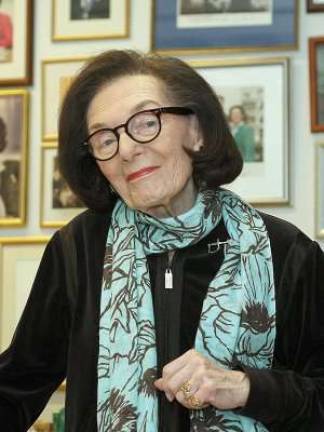Girl Scout of a Certain Age

National group's former leader is anything but retiring
By Megan Bungeroth
If Frances Hesselbein receives just a modicum more recognition in her life, which she very likely will, she'll have to get a new office. Every inch of her wall is covered with framed honorary degrees, photographs of her smiling and looking familiar with dignitaries and presidents and numerous translations of books she has edited on leadership.
Resting in a case above her couch, a military sword commemorates her tenure as the Class of 1951 chair for the study of leadership at the United States Military Academy at West Point. She wears on her jacket a miniature matching sword, along with her Presidential Medal of Freedom, presented to her by President Bill Clinton in 1998.
Some women who reach their nineties surrounded by the tokens of their lifetime accomplishments might take a little well-deserved time to relax, but Hesselbein's only major concession has been to cut down her weekly traveling schedule to once every two weeks.
Hesselbein, who prefers not to give her exact age, has been widely recognized for her work in leadership around the world. She credits her attitude and character as the hallmarks that brought her from a rural town in Pennsylvania to the Upper East Side.
"Leadership is a matter of how to be, not how to do," Hesselbein said, reiterating a mission statement she has spent her life promoting. "It is the quality and character of the leader that determines performance."
Hesselbein is the president and CEO of the Frances Hesselbein Leadership Institute, which until recently was called the Peter F. Drucker Foundation for Nonprofit Management. She's been running the organization since 1990, after she retired as CEO of Girl Scouts of the U.S.A.
Hesselbein was born and raised in the steel mill town of Johnstown, Pa., which she credits with giving her an upbringing surrounded by diversity. She attended a semester of junior college at the University of Pittsburgh but, despite her family's urging, decided to come home to help her mother and younger siblings after her father died suddenly when she was only 17.
She then worked for a few years until marrying John Hesselbein, a writer and documentary producer. The couple had a son (now deceased), and Hesselbein raised him and got involved in the local Girl Scouts, working her way up from volunteer to CEO of the local council. One day, in 1976, she got a call to interview for the national CEO position.
"I think I was very relaxed because I knew they couldn't be serious, if in all those years you've never had a within person," Hesselbein said of the Scouts' tendency to hire outsiders. "They said, 'Well, if you had this job, what would you do?' And I described the total transformation of the largest organization for girls and women in the world."
She landed the position and set to work implementing her plan.
"Because I had already described the transformation and vision, they bought it," she said. "There was no pushback. Everybody was together."
Hesselbein is credited with turning the Girl Scouts from a mostly white group to an incredibly diverse one. She also placed a greater emphasis on math, science and technology and began the Daisy program for kindergarten-age girls.
When she talks about these achievements, she always says "we," noting that all of the changes resulted from cooperation at many levels, an attitude that has become her hallmark as she espouses a flat leadership system in which a CEO is in the center of overlapping circles instead of at the top of a hierarchy.
When she retired from the Girl Scouts, Hesselbein, by then a widow, expected her life to settle down, but instead she was tapped to use her experience to train others in the ways of leadership.
"I bought a house in Pennsylvania, I promised Doubleday I would write a book on leadership-I wasn't going to travel at all-and six weeks later, I find myself the new CEO of the new Peter Drucker Foundation for Nonprofit Management, and I haven't been home since," she said.
Now Hesselbein spends her days running the Institute, giving web seminars and traveling-she's visited 68 countries and splits her time between her Upper East Side apartment and her house in Pennsylvania-to speak to young people and those who want to learn from her management style, which places service above personal ambition.
"Today we have a very passionate mission to strengthen the leadership of the social sector," Hesselbein said. "When you bring the three sectors together with common vision, common cause, common mission and we all work together, it's so much more powerful and productive."
When asked how one teaches the qualities of leadership, Hesselbein said that it's a matter of showing people opportunities.
"In 1846, Emerson wrote, 'Be an opener of doors,'" she said. "I just love that, and I think that any of us in any type of leadership have to be opening doors to younger leaders."